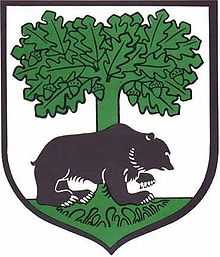Barwice
| Barwice | |||
|---|---|---|---|
| |||
 Barwice | |||
| Coordinates: 53°44′N 16°21′E / 53.733°N 16.350°E | |||
| Country |
| ||
| Voivodeship | West Pomeranian | ||
| County | Szczecinek | ||
| Gmina | Barwice | ||
| Area | |||
| • Total | 7.42 km2 (2.86 sq mi) | ||
| Population (2006) | |||
| • Total | 3,838 | ||
| • Density | 520/km2 (1,300/sq mi) | ||
| Postal code | 78-460 | ||
| Website | http://www.barwice.pl | ||

Barwice [barˈvʲit͡sɛ] (German: Bärwalde) is a town in Poland, in West Pomeranian Voivodship, in Szczecinek County.
Geographics
The town is located on the Baltic Uplands in Farther Pomerania at an altitude of about 150 to 180 meters above sea level within the upper region of the river Persante. 20 kilometers further south the Lakeland of Dramburg begins. The next larger city is Szczecinek (German Neustettin).
Since in 1999 the rail road between Grzmiąca (Gramenz) and Kostrzyn (Küstrin) had been closed down, a rail connection to Barwice does no longer exist.
History
The settlement is first mentioned as civitas Barwitz in historical records from 1286, but since it is located in the vicinity of a pre-historical salt road leading to the saltworks of Kolberg, it probably had been founded much earlier. The town and its neighbouring villages became in 1477 under duke Bogislaw X (1454–1523) part of the Duchy of Pomerania. In the 16th century the town and the surrounding lands of Bärwalde were in the possession of four noble families: von Glasenapp, von Wolde, von Zastrow and von Münchow. The oldest town seal of Bärwalde is from 1564 and carries the inscription Sigillum civitatis Berwoldie.[1] During the second half of the 16th century, duke John Frederick (1542–1600) granted to the town the right to hold trade fairs three times a year.
In 1626 a blaze destroyed parts of the town, including both the town hall and the church. Because of this, the town was freed from tax paying for the next five years. During the Thirty Years' War the town was occupied in 1630 by Swedish military of Gustav II Adolph (1534–1632) and suffered heavy damages. During the Seven Years' War Russian troups devastated the town's archives within the town hall, so that all older historical documents went lost.[2]
Since 1766 five fairs per year were allowed to be arranged.
Before World War II the town had been the site of a county court and of a customs office, and it had a secondary school. The local industry manufactured machinery and produced building materials made from sandstone. There existed both sawmills and grain mills. The town was a centre of agricultural trade, the main trade products being grain, potatoes and cattle.
In March 1945, short before the end of World War II, Bärwalde was occupied by the Soviet Army. After the end of the war the town was put under Polish administration. During subsequent months the German inhabitants were expelled.
Demographics
Before World War II the (then German) inhabitants of Bärwalde were predominantly protestantic.
- Number of inhabitants in years
- 1740: 472[3]
- 1783: 533; incl. six Jews.[3]
- 1794: 663; incl. seven Jews.[3]
- 1812: 804; incl. six Catholics and 34 Jews.[3]
- 1816: 854; incl. five Catholics and 59 Jews.[3]
- 1831: 1,180; incl. six Catholics and 85 Jews.[3]
- 1843: 1,571; incl. three Catholics and 129 Jews.[3]
- 1852: 1,741; incl. four Catholics and 143 Jews.[3]
- 1861: 1,964; incl. eight Catholics and 180 Jews.[3]
- 1900: 2,338[4]
- 1925: 2,530[5]
- 2004: 3,876
References
- Literature
- Gustav Kratz: Die Städte der Provinz Pommern - Abriß ihrer Geschichte, zumeist nach Urkunden. Berlin 1865 (reprinted in 1996 by Sändig Reprint Verlag, Vaduz/Liechtenstein, ISBN 3-253-02734-1; reprinted in 2011 by Kessinger Publishing, U.S.A., ISBN 1-161-12969-3), pp. 18–19. (in German, online).
- D. Franz Stelter: Der Kreis Neustettin. Würzburg 1972 (519 pages, in German).
- Notes
- ↑ Kratz (1865), p. 18 (in German)
- ↑ Christian Friedrich Wutstrack: Nachtrag zu der Kurzen historisch-geographisch-statistischen Beschreibung von dem königlich-preußischen Herzogtum Vor- und Hinterpommern. Stettin 1795, p. 228 (in German)
- ↑ 3.0 3.1 3.2 3.3 3.4 3.5 3.6 3.7 3.8 Kratz (1865), p. 19 (in German)
- ↑ Meyers Konversations-Lexikon. 6th edition, vol. 2, Leipzig and Vienna 1906, p. 411 (in German).
- ↑ Der Große Brockhaus. 15th edition, vol. 2, Leipzig 1929, p. 341 (in German).
External links
- Official town webpage
- High resolution satellite photo from Google Maps
- Jewish Community in Barwice on Virtual Shtetl
| ||||||||||||||||||||||||||||||||||||||||||||
| |||||||||||||||||||||||||||||||||||||||||||||||||||||||||||||||||||||||||||||||
Coordinates: 53°44′N 16°21′E / 53.733°N 16.350°E

